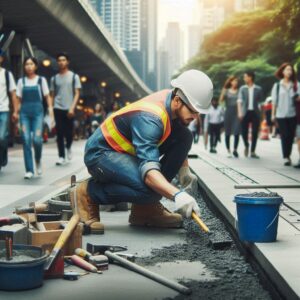How to Prevent Future Damage After Concrete Repairs
Key Takeaways:
- Implementing preventive measures extends the life of repaired concrete structures.
- Regular maintenance is crucial to avoid recurring issues.
- Understanding the impacts of environmental factors helps in planning effective prevention strategies.
Table of Contents:
- Introduction to Concrete Repair and Prevention
- Recognizing Vulnerabilities in Concrete Structures
- The Importance of Quality Materials and Techniques
- Regular Maintenance Practices
- Innovative Solutions for Enhanced Durability
- Environmental Considerations and Adaptations
- Addressing Common Concerns
Introduction to Concrete Repair and Prevention
Concrete repairs are a fundamental part of maintaining the integrity and safety of structures. However, to ensure the longevity of these repairs, it is crucial to adopt practices that prevent future damage. Recognizing the necessity of sustainable repair solutions can enhance structural performance and prolonged durability. For comprehensive insights into concrete repair and strategies to prevent damage, click here.

Recognizing Vulnerabilities in Concrete Structures
Identifying weak points in concrete structures is the first step in preventing future damage. Environmental factors, such as temperature fluctuations and moisture exposure, can lead to cracks and surface deterioration. Mechanical stresses, including heavy loads and vibrations, also pose significant threats. Understanding these vulnerabilities allows for implementing targeted solutions that mitigate potential risks. By regularly inspecting concrete structures, you can detect early signs of damage and address them promptly.
The Importance of Quality Materials and Techniques
Choosing the right materials and techniques is pivotal in enhancing the durability of concrete repairs. High-quality materials offer better resistance against environmental and mechanical stresses. Advanced mixtures like those incorporating supplementary cementitious materials improve performance and adaptability. Modern repair techniques, including epoxy injections and fiber reinforcement, can seal and strengthen vulnerable areas. Investing in superior materials and methods lays a strong foundation for enduring repairs.
Regular Maintenance Practices
Consistent maintenance is essential to sustaining the benefits of concrete repairs. Establishing a regular inspection plan aids in spotting emerging problems before they become more serious. Simple maintenance tasks, such as washing, sealing, and resurfacing, protect surfaces from contaminants and physical damage. Proactive measures ensure that repairs remain effective, reducing the frequency of costly interventions. Regular care extends the lifespan of concrete structures and enhances their safety and functionality.
Innovative Solutions for Enhanced Durability
Technological advancements in construction materials and techniques offer promising solutions for enhancing concrete durability. Innovations like self-healing concrete and advanced sealants provide additional layers of protection and longevity. Self-healing materials automatically eliminate minor cracks by automatically releasing repair agents, while advanced sealants offer superior water resistance and flexibility. Adopting these innovative solutions can significantly reduce the incidence of future repairs, promoting sustainable infrastructure development.
Environmental Considerations and Adaptations
Concrete structure wear and tear is significantly influenced by environmental conditions. Adapting to local climate conditions is crucial for prevention strategies. For instance, air-entrained concrete can minimize cracking in regions prone to freeze-thaw cycles. Similarly, in coastal areas, corrosion-resistant materials prevent saltwater exposure damage. Understanding the impacts of environmental conditions and adjusting repair strategies accordingly are vital for maintaining concrete integrity.
Addressing Common Concerns
Many property owners often express concerns about the durability of concrete repairs. Common questions include identifying potential issues and the frequency of necessary maintenance. Regular consultation with professionals and staying informed about advancements in repair materials and methods are key to addressing these concerns. Keeping abreast of the latest industry practices ensures informed decisions, safeguarding against future damage and repair costs.

